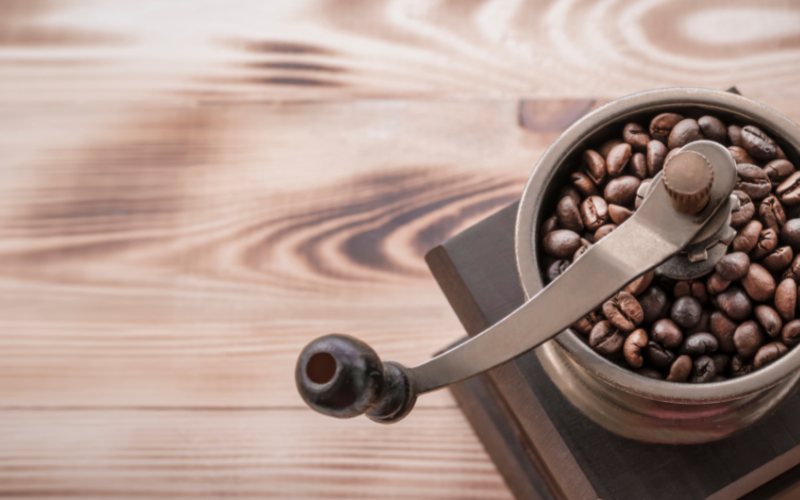How to Grind Coffee Beans: A Complete Guide
Why should you grind coffee beans at home?
How to choose the right coffee grinder
What are the different types of coffee grinders?
- Extra Coarse Grind
- Coarse Grind
- Medium-Coarse Grind
- Medium Grind
- Medium-Fine Grind
- Fine Grind
- Extra Fine Grind
Proper Coffee Grinder Maintenance
What's the best grind consistency for each coffee brewing method?
Common Mistakes When Grinding Coffee at Home
- Not keeping your grinder clean
- Using the wrong grind size
- Not shaking the grinder
- Not understanding your grinder settings
Get Freshly-ground Coffee from Veneziano
- How often should you grind coffee to keep it fresh?
- What does poorly extracted coffee taste like?
- What's under-extraction?
- What's over-extraction?
Whether you're a coffee aficionado or just enjoy the occasional cup, there's nothing quite like freshly ground coffee. But before you can enjoy that fresh-brewed flavour, you need to know how to grind your own beans. In this blog post, we'll show you how to do it like a pro. Keep reading for tips on choosing the right grinder, measuring your beans, and grinding them to perfection.
Why should you grind coffee beans at home?
Grinding your own coffee beans has a number of benefits. First of all, freshly ground beans produce superior flavour and aroma that can't be matched by store-bought pre-ground coffee. It also gives you more control over the particle size of the grind, which is important for getting the most out of your brewing method. Finally, it's just more fun to do it yourself.
Suggested reading: How to Find the Best Coffee Beans
Why does grind size matter?
Grinding your beans is the first step in unlocking their full flavour potential. Different grind sizes allow for different extraction times, resulting in a range of flavours and aromas in the cup. The finer the grind size, the slower the extraction time and vice versa. For example, espresso is best made on a finer grind size while French press coffee is brewed using a coarser grind.
How to choose the right coffee grinder
The type of grinder you choose will depend on your budget, preferences, and brewing method. If you’re just beginning to learn how to grind coffee beans, an entry-level burr grinder can be a good choice as it’s affordable and easy to use. For more experienced baristas, a manual or more complicated burr grinder will provide a wider range of grind sizes and greater consistency.
What are the different types of coffee grinders?

There are different types of coffee grinders on the market, so which one should you buy for your home espresso setup?
Blade grinder
Place beans in the grinder and pulse until you reach your desired consistency. Keep an eye on the texture to ensure it doesn’t become too fine. This type of grinder can be hard to replicate your grind size each time and you may find an inconsistency in particle sizes too.
Burr grinder
Select the size of grind you need and start grinding, adjusting time to achieve desired dose or grind amount. If your coffee is flowing too slowly you may need to move to a coarser number on the collar of the grinder or if your extraction is flowing too fast move to a finer setting. Be sure to only make minor adjustments at a time as a small change on your grinder can have a big impact.
Manual hand grinder
This is a great option if you don’t have the bench space for a larger grinder or the budget. These grinders are more affordable and can easily be packed into your suitcase when travelling.
Adjusted easily for a coarser or finer grind size. You will need some muscle power if you offer to make coffee for more than just yourself. Try to grind only what you need ensuring you have freshly ground coffee for each cup you are making.
How to measure your beans
Once you have chosen your grinder, it’s time to measure or dose (as we call it in the coffee industry) out your beans. To ensure consistency and accuracy, use a small set of scales for accurate measurements – this will help you adjust in the future if needed. Generally speaking, a dose of somewhere between 16-22 grams per cup of coffee is a good starting point. However, always refer to the instructions of your specific brewing method for more precise measurements.
When grinding coffee, it’s important to use the correct ratio of grounds to water for your preferred brewing method. For espresso, the ratio will be much lower as this is the most concentrated form of coffee brewing, where as a plunger or pour-over will have a much higher ratio.
The different Types of Coffee Grinds

There are many different types of coffee grinds, and each one has its own unique purpose. If you want to make quality coffee, it's important to understand which grind is best for your coffee maker and the type of coffee bean. Here are seven popular types of coffee grinds, along with their corresponding brewing methods.
1. Extra Coarse Grind
This grind is best used for cold brewing because it requires the longest extraction time. The coffee grounds are large and palpable, and you can still see some of their original markings and texture.
2. Coarse Grind
This is a more common grind size and is used for coffee cupping, French Press, and percolators.
3. Medium-Coarse Grind
This size of grind is often used for the specialty coffee brewing methods like Chemex and Cafe Solo as it allows for enough water to be absorbed by the grounds without too much over-extraction.
4. Medium Grind
A medium grind is the most common grind size for pre-ground beans. It has the texture of smooth beach sand. This grind is perfect for most drip coffee makers and siphon brewers.
5. Medium-Fine Grind
This grind size works best for cone-shaped pour-overs and AeroPress brewers with two to three minutes of brewing time.
6. Fine Grind
This type of grind is also easy to find in pre-ground bags and is often labelled as espresso grind. This grind is best used for espresso makers.
7. Extra Fine Grind
The extra-fine grind size has a texture like powdered sugar. Extra-fine grind is mostly used to make Turkish coffee and is sometimes called a Turkish grind.
You will never know if you have the perfect grind size until you brew your coffee and see how it tastes. The great thing about being able to grind your own coffee at home is that adjustments to grind size can easily be made
Proper Coffee Grinder Maintenance

No matter what kind of grinder you choose, it’s important to make sure it is cleaned regularly to ensure the best flavour and performance. If you are using a blade coffee grinder, be sure to give it a good shake while it is running to ensure an even grind. Give it a wipe out between grinding to remove any leftover grinds to ensure a fresh cup of coffee every time. With burr grinders, you should regularly clean away any leftover grinds in the chute and around the blades. An effective way of doing this is with a vacuum cleaner. If using a manual burr grinder, make sure to clean out any grinds from your previous coffee to ensure you are suing freshly ground coffee every time.
Remember, a well-maintained grinder is an essential part to a great cup of coffee, so don’t forget to give yours a bit of TLC.
What's the best grind consistency for each coffee brewing method?
The best grind size for each brewing method depends on the style of coffee you prefer. Here’s a quick guide to coffee grind sizes for the most popular brew methods:
- Cold Brew Method: Extra Coarse
- French Press: Coarse
- Pour-over (Chemex, V60): Medium-Coarse
- Cafetiere/French Press: Medium
- Drip Brewer (V60, Kalita Wave): Medium
- Espresso: Fine
- Turkish Coffee/Latte Art: Extra Fine
By following these tips and understanding each grind size, you can easily find the perfect grind for your favourite brewing method. Plus, you’ll be able to enjoy the freshest cup of coffee every time. Happy brewing.
Common Mistakes When Grinding Coffee at Home
Grinding coffee at home can be tricky, but it doesn’t have to be. Here are some common mistakes to avoid when grinding coffee beans at home:
Not keeping your grinder clean
Be sure to clean out any leftover grounds from the hopper after each use. This will help keep your grinder free of unwanted particles that can affect the flavour of your coffee
Using the wrong grind size
The type of coffee you’re making should determine your grind size. Make sure to use the correct one for each brewing method to ensure a great cup of coffee.
Not shaking the grinder
If you are using a blade grinder, give it a shake while it’s running to ensure an even grind.
Not understanding your grinder settings
Whichever type of coffee grinder you have on hand, make sure to understand the grind settings. This will help ensure that you get to customise your grind size for the best flavour.and extraction time.
By following these tips and understanding each grind size, you can easily master the perfect grind for your favourite brewing method. With a little practice, you’ll be able to enjoy the freshest cup of coffee every time.
Get Freshly-ground Coffee from Veneziano
Don't have a coffee grinder at home yet? You can get your coffee beans ground for free when you buy your favourite coffee blends from Veneziano Specialty Coffee Roasters. Depending on your desired brewing method, whether it's espresso, stovetop, plunger pot, or pour-over, Veneziano can grind your beans to the perfect consistency before sending them over to your doorstep.
You can also shop for coffee grinders online in case you want to build your coffee-making arsenal at home.
Frequently Asked Questions
How often should you grind coffee to keep it fresh?
You should grind coffee beans as close to the time you plan to brew them as possible. The ground coffee will start to degrade as soon as they're ground, and the resulting coffee will have a less complex flavour.
Ideally, you should grind just enough beans for the amount of coffee you plan to make. If you have any leftover ground coffee you don’t want to waste, store it in an airtight container in a cool, dark place.
Suggested reading: How to Store Coffee Beans to Keep your Beans Fresh
What does poorly extracted coffee taste like?
Most people would say that it tastes sour, acidic and thin if under-extracted and heavy and harsh if over-extracted.
Brewing coffee is all about extracting the flavour from the beans. If the extraction process is not done properly, then you will end up with a cup of coffee that doesn't taste very good. This is why it's important to use a quality coffee maker and to grind your beans fresh every time you make a cup of coffee.
What's under-extraction?
Under-extraction is when a coffee brewer doesn't produce an adequate amount of coffee solids in the brew. This can be caused by using too much hot water, using water that's not hot enough, or using coffee that's too coarsely ground. As a result, the resulting cup of coffee will be thin and watery with very little flavour.
Under-extraction is a common issue with home brewers who are just starting out. It can be tricky to get the grind size and brew time just right, so it's important to do some experimentation until you find what works best for your setup. Fortunately, under-extraction is easy to fix; all you need to do is adjust the grind size finer which will adjust your brew time until you get the desired results. You can also play around with your dose too. Adding a little more coffee can bring more flavour and strength to your cup.
What's over-extraction?
Over-extraction occurs when coffee is brewed for too long, when you used too much coffee, or when the beans are too finely ground. When this happens, the coffee will become bitter and astringent, heavy and harsh.
To avoid over-extraction, make sure to use the correct grind size for your brewing method. If you're using a manual brewer, such as a plunger, be sure to time your brew and pour out the coffee before it over-extracts. If you are extracting an espresso, watch how it pours. It should pour with some resistance to begin and open up to a faster more caramel-coloured extraction, finally paling out around the 25-30 second mark. Most specialty coffee roasters will provide you with a recipe card for each of their blends to help you achieve the perfect extraction.



